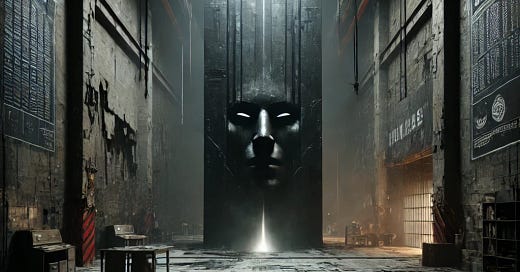The Narcissistic Blueprint: How Toxic Leaders Infect Organizations and Rewrite the Future
A Case Study in Makerspace Corruption, Social Decay, and the Cost of Leadership Blindness
There is a pattern.
It begins with a vision—a grand, ambitious dream built on passion, community, and shared purpose. An idealistic structure where innovation thrives, where people collaborate without rigid hierarchies, where leadership serves rather than controls.
And then, something happens.
Not suddenly, not in an obvious coup—but in small, insidious shifts.
A parasite enters the system.
Not with force, but with charisma. With control disguised as competence. With an ego that hides behind the mask of “leadership.” And once it’s in, the pattern begins.
Stage 1: The Idealist Builds, the Narcissist Waits
At the beginning, there is energy—pure and boundless. The founders aren’t power-hungry; they’re builders, creators, visionaries. They establish bylaws with good faith, assuming that future leaders will share their values.
But the first fatal flaw of idealists is believing that everyone shares their ethics.
They don’t anticipate the gameplayers.
They don’t see the future narcissists lurking, watching, waiting—until the system is big enough, influential enough, worth taking.
Stage 2: The False Champion Steps In
When the organization gains traction, when its reputation solidifies, the first infection takes root.
The narcissist doesn’t enter as an aggressor. No—they enter as the golden child. The most active volunteer. The most committed. The most involved.
They mimic passion until they are trusted. They mimic leadership until they are given a title.
They mimic loyalty until they no longer need to.
Stage 3: The Slow, Systematic Shift to Control
Once inside, the narcissist begins rewriting reality—not through force, but through subtle policy changes, quiet purges of dissenters, and the slow centralization of power.
Rules that once encouraged community suddenly become about control.
Open discussions are replaced with private backroom decisions.
Accountability structures are slowly eroded, because "trust us" replaces transparency.
The leaders who resist? Pushed out. Ostracized. Silenced. Their warnings reframed as drama. As paranoia. As instability.
The new culture forms: Compliance, or exile.
And the worst part? The infection doesn’t stop at the top.
Stage 4: The Culture Shifts to Defend the Narcissist
Once the narcissist locks in control, they don’t need to fight battles themselves. The culture now fights for them.
Loyalists emerge—not because they agree, but because it's safer to align with power.
Former friends of the narcissist begin justifying their abuses, convincing themselves that it’s not really that bad.
The organization itself becomes an enabler, normalizing toxicity under the guise of “stability.”
And here’s the worst part: The narcissist doesn’t need to stay in power for their infection to survive.
Because once the culture changes, once people accept that control is normal, once policies are rewritten to serve dominance over collaboration…
…the damage is permanent.
The narcissist can leave. Their imprint remains.
Stage 5: The Next Generation Carries the Infection Forward
Here’s the final, devastating truth about narcissistic leadership:
By the time people recognize the corruption, it’s too late.
Even if the narcissist is removed, the system they created remains.
The next leader inherits a corrupt structure, and unless they actively dismantle it, the cycle repeats.
And this is why Dallas Makerspace still operates under the shadows of Andrew LeCody.
Not because he’s still in power. Not because he’s still pulling the strings.
But because the patterns of corruption and control he seeded never died.
Lessons from a Leadership Failure: How to Break the Cycle
The story of Dallas Makerspace is a warning. It is not unique.
This happens everywhere. In nonprofits. In corporations. In startups. In government.
Anywhere that power can be seized, narcissists will attempt to take it.
And if we don’t change how we recognize, prevent, and dismantle these patterns, we will keep building things that get hijacked by the very people least qualified to lead them.
How Do We Stop This?
🔴 Codify Ethical Leadership
Bylaws need more than just rules—they need firewalls against power centralization.
Every position must have strict term limits. Power should never become indefinite.
🔴 Public Accountability, Not Private Control
No leader should be untouchable.
Every decision should be transparent.
Leaders should be required to answer for their actions publicly.
🔴 Red Flags Must Be Treated as Contagions
If a leader rewrites history, dismisses critics as "crazy" or "obsessive," or controls information flow, they are a threat to the organization.
Do not excuse toxicity just because someone is "useful."
If an organization protects its leadership more than its members, it has already failed.
Final Thoughts: The Cost of Looking Away
I was there.
I built Dallas Makerspace. I wrote the bylaws, mentored its leaders, believed in its vision.
And I failed to see the infection when it arrived.
By the time I recognized Andrew LeCody for what he was, it was too late. The system had already been rewritten, and the people who could have stopped it had been silenced.
If we don’t study these patterns, if we don’t name them, if we don’t build systems that resist their influence, then we will keep building things just to have them stolen.
And that?
That is the true tragedy of every idealistic movement that never realized it had been compromised until it was already too late.
Now, We Decide
Will we keep excusing toxic leadership?
Will we keep letting narcissists manipulate idealistic structures into instruments of control?
Or will we force accountability, rebuild the rules, and make sure the parasites never win again?
The choice is ours. But the cost of looking away is permanent.




